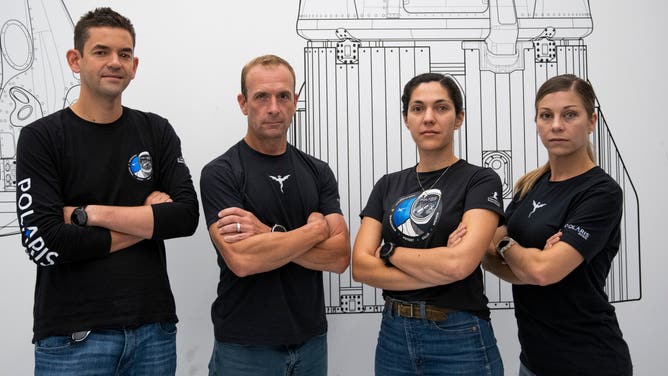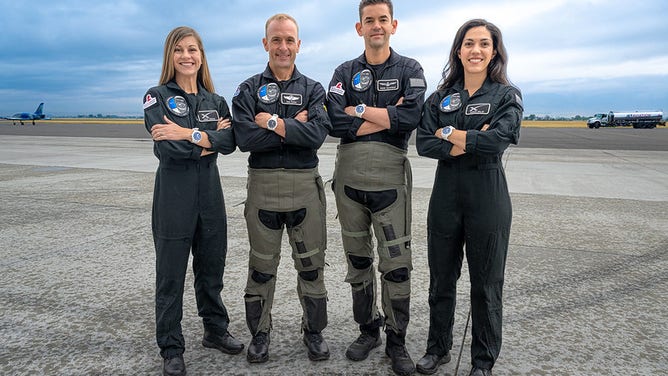First private spacewalkers reveal jampacked science goals during Polaris Dawn mission
Over the five-day spaceflight, the Polaris Dawn crew will be nearly 870 miles above Earth, about four times higher than the International Space Station.

The Polaris Dawn crew wearing smart contact lenses that will study fluid shifts during their five-day spaceflight in 2023. (Image credit: Polaris Program)
Four private astronauts launching with SpaceX in March under the Polaris Program plan to conduct dozens of science and research experiments designed to study human health and plant growth in space.
Founded by businessman and pilot Jared Isaacman, the Polaris Program's first mission, known as Polaris Dawn, will launch on a SpaceX Crew Dragon spacecraft no earlier than March 2023. It will be the first time a non-government astronaut crew will conduct a spacewalk in the vacuum of space.
Isaacman will be joined by retired U.S. Air Force Lt. Col. Scott Poteet and two SpaceX employees, Sarah Gillis and Anna Menon. Both Gillis and Menon have worked with NASA astronauts launching with SpaceX and will now experience flying on Crew Dragon themselves.
Similar to the Inspiration 4 mission Isaacman launched on last year with three other civilians, the upcoming Polaris missions will also include science and research that will benefit from the low-gravity environment.
On Monday, the Polaris Program revealed it has partnered with 23 research institutes and universities to potentially send 38 experiments on the five-day mission. Those partners include NASA, science-backed by SpaceX and multiple leading medical institutions and universities.
"Our science and research agenda will enhance the body of knowledge for future long-duration spaceflight, which will take us back to the moon and on to Mars; as well as progress our knowledge and understanding for humankind here on Earth," Isaacman said in a statement. "The Polaris Dawn team along with the exceptional science and research team at SpaceX cast a wide net to find the best experiments to fly with us."
While the mission's timeline hasn't been released yet, including how many of the four private astronauts will be conducting spacewalks, the crew won't just enjoy the breathtaking views but will be part of many experiments themselves.
"We will make every minute of our 5-day mission count," Isaacman said in a tweet.
The crew will test ultrasound imaging to monitor changes inside the body, including making 3-D images of the eye to understand microgravity's effects on eyesight. The University of Colorado Boulder plans to study pressure inside the astronauts' eyes by having them wear smart contact lenses.
Menon shared a video on Twitter showing what the contacts look like when in place.
Other experiments include studying bone and muscle loss caused by weightlessness, a known issue for astronauts living and working in space.
A glucose monitoring experiment by SpaceX will study how astronauts can manage their diabetes while in space.
Over the five-day spaceflight, the crew will be nearly 870 miles above Earth, about four times higher than the International Space Station. This orbit will take the Crew Dragon spacecraft through part of the Van Allen radiation belt, allowing for research on how space radiation affects human health.
Keck School of Medicine of USC plans to study if ambient space radiation can be used to achieve in-flight X-ray radiographs in space to diagnose astronauts in the future.

Polaris Dawn crew from left to right: Anna Menon, Scott Poteet, Jared Isaacman and Sarah Gillis. (Photo credit: John Kraus/Polaris Program)
While in space, some astronauts have described seeing flashes of light while their eyes are closed, caused by radiation exposure. NASA has proposed taking radiation measurements during the Polaris Dawn mission because of the unique orbit to study the light flash phenomenon.
Some studies will be conducted after the Dragon splashes down, ending the mission.
Within hours after the astronauts land, they will undergo brain MRIs for a Medical University of South Carolina study to observe possible changes after their spaceflight.
Polaris Dawn launches in March 2023 from Kennedy Space Center in Florida. Closer to launch, the program will share a final list of experiments approved to fly.
The final flight under the Polaris Program would be the first human spaceflight of SpaceX's newest vehicle, Starship.